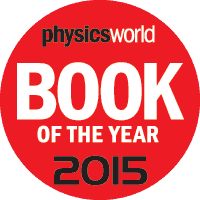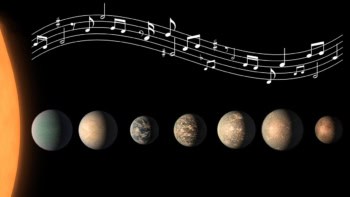By Margaret Harris
 Well written, scientifically interesting to physicists, and novel: these are the criteria used to select Physics World’s annual list of the year’s top physics books. We’ve done this every year since 2009, and over the past few weeks, we’ve been at it again, sifting through the 52 books reviewed in the magazine in 2015 and separating the best from the rest (most of which, I should add, are also very good – we try not to review bad books).
Well written, scientifically interesting to physicists, and novel: these are the criteria used to select Physics World’s annual list of the year’s top physics books. We’ve done this every year since 2009, and over the past few weeks, we’ve been at it again, sifting through the 52 books reviewed in the magazine in 2015 and separating the best from the rest (most of which, I should add, are also very good – we try not to review bad books).
This is never an easy task, and as usual, the selections in our shortlist have been influenced by the views of external experts: the physicists, science writers and science historians who read and reviewed books for Physics World magazine throughout 2015. Their reviews (and, in a few cases, their private opinions) helped us decide which books deserved a closer look, and we thank them all for their contributions.
Deciding on a winner, however, is a privilege we reserve for ourselves, and with so many great books to choose from, it has been both a privilege and a challenge this year. We’ll be announcing our “Book of the Year” in a special edition of the Physics World podcast later this month, but in the meantime, here are the candidates:
Life on the Edge: the Coming of Age of Quantum Biology by Jim Al-Khalili and Johnjoe McFadden
Co-authored by a nuclear physicist and a molecular biologist, this account of how quantum effects play out in biological systems takes readers right to the heart of one of the hottest topics in interdisciplinary research. In her review, biophysicist Marta Varela called the book “outstanding” in the breadth of its science and scholarship, and you can hear more about it from Al-Khalili and McFadden themselves in our podcast “A quantum sense of smell”.
Physics on Your Feet: Ninety Minutes of Shame but a PhD for the Rest of Your Life by Dmitry Budker and Alexander Sushkov
Not long ago, postgraduate physics students at the University of California, Berkeley, had to pass an oral exam as part of their PhD training. The exams were discontinued in 2010, but for those who feel miffed at missing out on this rite of passage, Budker and Sushkov have thoughtfully collected some of the best questions and presented them in this delightfully tongue-in-cheek compilation. The inventive and challenging puzzles in this book are guaranteed to make you think – and they will probably also make you glad you’re not encountering them “on your feet” in an exam.
Half-Life: the Divided Life of Bruno Pontecorvo, Physicist or Spy by Frank Close
Bruno Pontecorvo was the only nuclear physicist to defect from the West to the Soviet Union during the Cold War. But that doesn’t mean he was a spy. Or does it? Close’s book digs deeply into the history and science of this still-unsolved mystery of 20th-century physics, and according to reviewer Simone Turchetti (himself the author of a major Pontecorvo study), Close’s “contagious enthusiasm” brings us closer to answers than ever before.
Trespassing on Einstein’s Lawn: a Father, a Daughter, the Meaning of Nothing and the Beginning of Everything by Amanda Gefter
“How would you define ‘nothing’?” With this deceptively simple question, Gefter’s father launched her on a quest that would change her life, enrich his, and eventually become the subject of this book about her efforts to get to grips with the deepest questions in theoretical physics. Praised by reviewer Melanie Windridge as “an enlightening journey through the extremes of modern physics to the edge of the universe” (albeit one with a few too many F-words in it for her taste), it’s an unusually personal examination of what physicists do and do not understand, and you can hear more about Gefter’s quest in our June podcast.
Beyond: Our Future in Space by Chris Impey
Impey is seriously enthusiastic about space exploration. In his view, the desire to explore and push the boundaries of our environment is part of what defines us as human; it is, he argues, “built into our DNA”. Crucially, though, he’s also a clear-eyed scientist, and his book offers a penetrating analysis of some of the barriers standing in the way of this destiny. It’s particularly insightful on the “new space” movement and how private companies such as Elon Musk’s Space X are reshaping the space industry. This is the second time Impey has appeared on our list of the year’s best books, having also received the nod in 2010 for How It Ends.
The Water Book: the Extraordinary Story of Our Most Ordinary Substance by Alok Jha
“Water, water, everywhere”. In this ambitious book, Jha explores the substance that permeates the lives (and bodies) of every organism on our planet. It’s a fascinating topic, since (as reviewer Helen Maynard-Casely points out) water is “a substance that never quite does what we expect”. In telling its story, Jha serves up an exciting mix of science, history and adventure that’s sure to entertain readers and teach even water experts a thing or two.
Monsters: the Hindenburg Disaster and the Birth of Pathological Technology by Ed Regis
Nowadays, most people would agree that flying across the Atlantic below a giant bag of ridiculously flammable hydrogen is not a smart idea. For a few decades in the early 20th century, though, and despite their disturbing tendency to (literally) crash and burn, airships were considered the wave of the future. Regis’ provocative book analyses the reasons for their popularity and introduces the concept of “pathological technologies” to explore other, less famous ideas that never should have left the drawing board.
Tunnel Visions: the Rise and Fall of the Superconducting Super Collider by Michael Riordan, Lillian Hoddeson, Adrienne Kolb
While we’re on the subject of big ideas that never made it to fruition, one of the most important examples in physics is surely the Superconducting Super Collider (SSC). This particle-physics behemoth was meant to put the US at the forefront of high-energy science, but a host of scientific and bureaucratic problems meant that it fell victim to Congressional funding cuts in 1993, leaving behind a trail of recriminations and a 22.5 km hole below the Texas prairie. Riordan, Hoddeson and Kolb examine the SSC’s history in fascinating, forensic detail in this impressive book, which reviewer Andrew Robinson described as “vital reading for anyone interested in the complications of funding ‘big science’”.
The Copernicus Complex: the Quest for our Cosmic (In)Significance by Caleb Scharf
The Earth is not the centre of the universe. We’ve known this since (at least) the days of Copernicus, and over the centuries, the principle of our “cosmic mediocrity” has permeated deeply into the way scientists think about the universe. But there are also some ways in which we are special, and Scharf explores them with great sensitivity in this book, which reviewer Tamara Davis praised as “An amazingly thorough, yet accessible, exposition of our knowledge of the formation of the universe and the evolution of everything in it.”
Atoms Under the Floorboards: the Surprising Science Hidden in Your Home by Chris Woodford
As our 2014 book of the year demonstrated so well, physics is not only about the big, esoteric stuff “out there” in the cosmos. It’s also a subject that relates intimately to the stuff we see every day. Woodford’s snappily written analysis of ordinary “household” science takes a sideways look at the physics of objects found in and around a typical British home, from the car parked outside to the heating systems that keep the inhabitants snug when they curl up with a book on a cold winter night.



